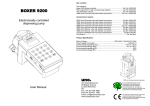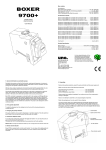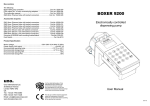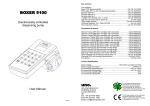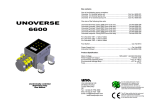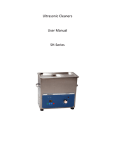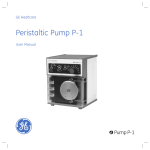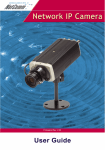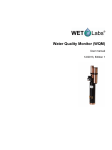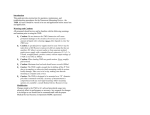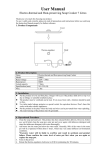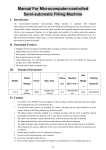Download Operating Manual
Transcript
Box contains The following: Unoverse 9100 pump controller..........................................Cat. No. 9100.000 PSU output 12V 0.3A with universal plug adapters ................... Cat. No. 6025 This instruction manual .....................................................Cat. No. 9100.6001 IDØ2.0 Santoprene tube .....................................................Cat. No. 9000.502 Accessories & spares: Silicone Tubing IDØ1.0mm complete with connectors..................... Cat.No.9000.504 Silicone Tubing IDØ2.0mm complete with connectors..................... Cat.No.9000.505 Santoprene Tubing IDØ1.0mm complete with connectors ............... Cat.No.9000.501 Santoprene Tubing IDØ2.0mm complete with connectors ............... Cat.No.9000.502 Santoprene tubing ID Ø2.00mm1meter running length ................... Cat.No.9000.506 Silicone tubing ID Ø1.00mm1meter running length ......................... Cat.No.9000.507 Silicone tubing ID Ø2.00mm1meter running length ......................... Cat.No.9000.509 Silicone tubing ID Ø3.00mm1meter running length ......................... Cat.No.9000.508 Unoverse 9100 wall mounting bracket/stand ................................... Cat.No.9100.001 Foot Switch ............................................................................................ Cat. No 6013 Electronically controlled dispensing pump Product Specification: Mains Voltage ................................................ 100V-240V 0.3A MAX 47-63Hz Power Supply Unit output .......................................................... +12VDC 0.5A Environmental operating temp ............................................... +10°C to +40°C Environmental storage temp .................................................... +4°C to +40°C 6&,/2*(; 6&,/2*(;//& )RXU5RG5RDG6WH %HUOLQ&72 U6$ Tel.: FAX: Email: LQIR#VFLORJH[FRP www.VFLORJH[FRP User Manual The CE sign certifies that the instrument meets the requirement of the EEC directives and has been tested according to the specified test methods. ISS1/11 Chemical compatibility chart Linseed Oil Potassium salts Chronic acid Magnesium salt Silver salts Acetic Anhydride Chromium salts Maleic acid Soap solutions Acrylonitrile Copper salts Manganese salts Sodium salts Aluminum Chloride Ethylene glycol Mercury salts Sodium hydroxide Aluminum sulfate Ferric salts Methanol Sodium hypochlorite Ammonia Fluoborate salts Natural gas Stearic acid Ammonium salts Fluoboric acid Nickel salts Sulfur dioxide Ammonium hydroxide Amyl acetate Fluosilicic acid Nitric acid-10% Sulfuric acid, dil. Formaldehyde Nitroethane Sulfurous acid Antimony salts Formamide Nitrogen oxides Tannic acid Arsenic salts Formic acid Nitrous acid Tanning extracts Barium salts Glucose Oils, animal Trisodium phosphate Benzoic acid Glycerins Oils. mineral Urea Bleaching liquor Hydrochloric acid Oils. vegetable Uric acid Water Boric acid Hydrocyanic acid Oxalic acid Bromine Hydrogen peroxide Oxygen Water (brine) Butyric acid Hydrogen sulfide Phosphoric acid Water (stoam) Calcium salts Iodine and solutions Phthalic acid Zinc salts Carbon Dioxide Lactic acid Phosphoric acid Chlorine (wet/dry) Lead salts Plating solutions Acetates Butane Me Et Ketone Skydrol 500-B4 Acetone Butanol Nitric acid-30% Sulfuric acid-90% Alcohols Essential Oils Nitrobenzene Tetrahydrofuran Amyl alcohol Ethers Oleic acid Turpentine Aniline Ethanol Phenol Benzaldehyde Furfural Propanol Benzyl alcohol Lithium grease Pyridine Benzene Cyclohexane Kerosene Nitric acid- 70% Carbon tetrachloride Ethyl chloride Trichloroethylene Perchloroethylene Chlorobenzene Chloroform Freon Gasoline, unleaded Lacquer Naphtha Toluene Xylene Moderate effect Chloroacetic acid Acetic acid 1. Q. Why does the pump stalls or runs slower than expected when new tubing is installed? A. A new Santoprene tube is stiff when new so has to be shaped for some time before it gains it’s elasticity. Run the pump in continuous mode for a total of approx 5 minutes with the clamp lever half open to start with, gradually moving the clamp lever to fully closed position. 2. Q. What is the life of the tube? A. The life of a peristaltic tube depends on many variants such as speed, the reagent it is pumping and temperature. In general you should expect approximately 800 hours operation from one tube. 3. Q. Why does the displayed value sometime ‘jump’ in double figures? A. This happens when dispensing small volumes with the ID2.0mm tubing. Following the calibration procedure the instrument’s mathematical calculation divides the volume to be dispensed by the number of pulses received from the motor’s encoder and stores this value. If the volume per rotor rotation is relatively large, the ratio of pulses to volume is coarse. In these circumstances the required volume input does not divide into stored values, and therefore the calculator will round up or down to the nearest whole figure. Whenever you use the ID1.0mm tube, the dispensed volume per rotor rotation is small enough to allow single μl per displayed digit. 4. Q. Can I leave the unit switched ‘ON’ throughout the day? A. Yes, you can. The dispenser requires very little energy when the pump is not running so continuous power into the unit will not harm it. 5. Q. Why can’t I set slower dispense speed ? A. The motor’s speed is controlled via the voltage supply to the motor. Too low voltage and the pump’s motor will stall, in particular when the tubing is new and the resulting load on the motor is higher. 6. Q. Can I dispense hot reagents using the dispenser? A. Yes, the dispenser to works safely with media temperatures of up to 100°C. Be aware that the internal electronics could be damaged by any ingress of fluids or steam vapours. Severe Acetaldehyde Little or no effect on Satoprene 13. FAQ Page 9 7. Changing the pumps direction 1. A. Unpacking The pump controller can be used for dispensing or aspirating reagents. The slide switch on the left side of the unit sets the direction that the pump rotor rotates. Remove the packing materials, unpack the pump controller and the power supply unit. 8. Pump speed adjustment Make sure that you have all the following components. To adjust the dispense speed press ‘SPEED+UP’ to increase or ‘SPEED+DOWN’ to decrease. Unoverse 9100 pump controller ........................................... Cat. No.9100.000 Power supply unit ................................................................. Cat. No.9100.004 IDØ2.0 Silicone tube ........................................................... Cat. No. 9000.509 You can adjust the speed from a maximum of 255 to a minimum of 180. 9. Continuous dispense mode To run the pump continuously press ‘VOLUME+START’. You can stop the pump at any point by pressing the ‘STOP’ button. The pump displays ‘Cont’ to indicate continuous running. Please note: running the dispense tubes dry over a long period will shorten their life. 10. Care & maintenance The control unit is maintenance free. The peristaltic tubes however require replacement as soon as excessive wear or a large variation in dispense volumes are noticed. The operational life of the tubes is a function of the speed, load and materials being dispensed. Avoid running the tubes dry for longer than a few minutes. Check the peristaltic tubes weekly for signs of excessive wear and replace if required. Pump tubes which remain clamped in the pump will deform with time. Therefore, rotate the tube clip at the top of the pump to ‘open’ position in order to relieve the pressure whenever the pump is not being used for long periods or overnight. 11. Exclusion If the equipment is used in a manner not specified by the manufacturer, the protection provided by the equipment might be impaired. This unit is NOT suitable for use in explosion hazard environments. Page 8 Please contact your supplier immediately if you notice any one of the components is missing or damaged. Note: Do not attempt to assemble a unit using damaged components. Retain the packaging so it can be used for future shipping The plug-in power supply unit is Switch Mode and automatically adjusts itself to the mains power supply characteristics. It will work with any mains voltage supply from 100V to 240V. The power supply unit is shipped with three alternative plug adaptors to fit European, American and UK power outlets. Select the correct adaptor for your needs and clip it into the power supply. 2. General information on peristaltic pumps Peristaltic tube pumps are ideal for fluid transfer, metering and dispensing. In contrary to centrifugal and gear pumps, peristaltic pumps handle fluids of various viscosities, are self priming and can operate in either flow direction. With no valves, seals or packing to come in direct contact with the pumped fluid, they are ideal for pumping high purity & corrosive fluids and for contamination free dosing. The principle of the peristaltic pump is based on a tube which is squeezed by a series of rollers. As a general rule, the higher the number of rollers and the smaller the tube diameter—the lower are the flow rates but better is the accuracy and precision. The 9100 controller is equipped as a standard with 3 roller system and Ø2.0mm ID tube. This tube diameter together with maximum speed delivers a flow rate of 50ml/min. This combination offers an ideal tool for applications which require volumes between 500μl and 50ml. For smaller dispense volumes use the Ø1.0mm ID tube. The pump is also designed to work in continuous mode. The highest dispense accuracy is achieved by using a semi rigid tube on the outlet of the pump. We recommend thin wall tubing such as FEP tubing ID1.5mm X OD2.1mm or PVC tube. Page 1 1. 5. Adjusting the dispense volume The peristaltic tube The peristaltic tube is made from Santoprene and the connectors are Nylon (PA). Please make sure the reagents you intend to use are compatible with these materials (See Chart). Press keys ‘VOLUME+UP’ or ‘VOLUME+DOWN’ to enter the volume nearest to your desired volume. 1. A. Clamping the peristaltic tube You can set the unit to dispense the desired volume for a number of times in predefined intervals. This feature is useful in repeatable operations either in manual mode or when the dispense head is held by a robotic arm. Make sure the tubes terminate in a receiving vessel and press ‘START’ to begin dispensing. For priming or to dispense more than the set volume , hold down the START key. 6. Interval Dispense The pump controller is delivered with a IDØ2mm Santoprene tube. In order to reduce deformation caused by clamping the pressure lever(1) is supplied in the open position . (1) The pressure lever moves the pump cover towards the rollers and thus clamps the tube between the cover and the rollers. 1.B. Releasing the peristaltic tube when you have finished 2. Whenever the pump is not in use for long periods of time it is important to release the pressure off the tube. This will reduce the possibility of the tube’s permanent deformation and ensure that accuracy/precision is maximised. 3. 4. 5. 6. Release the pressure by lifting the pressure lever 1.C. Replacing the tube For work in small volumes use the IDØ1.0mm tube which is available as an accessory. Lift the lever and remove the pump’s cover. Pull out both tube holders and remove from the cover. Replace with a new tube. 7. 8. 9. 10. 11. 12. Page 2 Interval time setting: Select between intervals of 1-99 sec or 10 to 990 seconds. Press and hold down the ’INTERVAL’ key and press ’DOWN’ key to select 1 to 99 seconds or ’UP’ key for 10 to 990 seconds. If you are not sure in which mode the instrument is, enter the desired mode prior to any further programming. Press ‘INTERVALS’ - the display flashes the first two digits to the left. These digits denote the time in seconds between the dispense operations. Using the ‘UP’ & ‘DOWN’ keys enter the number of seconds or 10Xsec you wish to have between the dispenses— from 1 second to 99 seconds. Press ‘INTERVALS’ and the second set of digits will flash. This digits denote the number of dispenses you wish to have—from 1 to 98 dispenses. Using the ‘UP’ & ‘DOWN’ keys enter the number of dispense events—between 1 and 98. Press ‘INTERVALS’ and the display will show the volume. The colon between the two sets of digits flashes to indicate that an interval dispense mode has been entered into the unit. You can now adjust the volume as indicated in the previous paragraph. Press ‘START’ and the controller will dispense the set volume in the interval mode which you have entered into the unit. Press ‘STOP’ + ’INTERVALS’ button to stop the intervals mode. The flashing colon will disappear from the display. To change any of the interval parameters simply press the ‘INTERVALS’ key again and enter new parameters Panic stop: You can press the ‘STOP’ button at any point throughout the dispense mode to terminate the automated dispense operation. Note that in the dispense process the display shows the seconds left before next dispense and the running event number. Continuous dispense: To dispense your chosen volume continuously at the interval time you selected, enter ‘99’ as the number of repeats. This will prompt the unit to dispense continuously until the STOP button is pressed. Remember to check the tubing condition from time to time. 00:00 03:00 03:08 8 events 1. 3 seconds intervals Before use ensure you turn the lever down to the fully clamped position To set repeat dispensing: 0.5:20 0.5:99 Page 7 4. Gravimetric pump calibration procedure 3. The choice of tubing Pump flow performance is subject of many factors among them the condition of the peristaltic tube and the viscosity of the reagent. It is therefore important that you calibrate the pump before it is commissioned and at periodic intervals. The unit can work either with fixed length tubing—75mm long within the tube clamp, or with continuous tubing which in effect does not have any length restriction. In both cases, the correct tube clamps have to be installed in the clamp. IMPORTANT: CHOOSE THE CALIBRATION VOLUME THAT MATCHES THE RANGE YOU ARE MOST LIKELY TO USE IN YOUR APPLICATION. There is one size of clamp for the fixed clamp tubing which is supplied as part of the tube. The default calibration volume is 1.000. You can however choose any other calibration volume which is most suitable for your application. For the continuous tubing there are three sizes of clamps. 1. 2. 3. 4. 5. Press ‘CAL + START’ to display the default calibration value of 1.000 Carry out five dispenses into a vessel and establish the gravimetric volume dispensed in each operation. Calculate the mean delivery volume. Enter the calculated mean value into the unit by pressing ‘CAL+UP’ to increase the displayed volume or ‘CAL+DOWN’ to decrease. The unit is now ready for use and you can now set the volume you would like to dispense. 1. 2. 3. Marked ‘1’ for ID1.0mm tube Marked ‘2’ for ID 2.0mm tube Marked ‘3’ for ID 3.0mm tube The easiest roller position for tube replacement is when one roller is at the top of the pump. You can turn the roller wheel with your fingers until you reach this positioning. Calibration using other than the default calibration value 1. 2. 3. 4. 5. 6. 7. Press ‘CAL + START’ to display the default calibration value of 1.000ml. Press ‘CAL+RANGE’ to move the decimal place so that the unit displays the volume in the range in you prefer for example if your work involves dispensing ml’s rather than μ’s, move the decimal point to display 10.00 Press and hold ‘VOLUME+UP’ or ‘VOLUME+DOWN’ until the desired volume for calibration is displayed. Carry out five dispenses and establish the gravimetric volume dispensed in each operation. Calculate the mean delivery volume. Enter the calculated mean value into the Unoverse unit by pressing ‘CAL+UP’ to increase the displayed volume or ‘CAL+DOWN’ to decrease the displayed volume. The unit is now ready for use. When using continuous tubing, make sure that the tube is fitted so that it is in contact with the inner surface of the tube clamp. Page 6 Page 3 4. Preparing the pump for use Plug the supplied PSU into your power socket and the low voltage plug into the socket on the left side of the unit, switch it on by pressing the ‘ON’ button. The green LED will illuminate indicating that the unit is operational. The display will temporarily read ‘9100’ and then default to the value 1.000 . This value is the factory setting. Note the direction of flow. The pump is reversible using the slide switch, so you can return any unused reagent back into the reservoir. 3. The Control Panel The keys on the control panel are assigned with functions to calibrate the pump, set the volume to be dispensed, set speed and ‘interval of dispense’. Some of the keys must be operated in pairs to enter certain functions. In such cases, the keys should be activated in the following sequence : VOLUME+UP ....................................................................... Increase volume VOLUME+DOWN ............................................................... Decrease volume START ..................................................................... Start dispense operation VOLUME+START ..........................................................Continuous dispense STOP ...............................................................Stop dispense (‘panic button’) SPEED+UP ....................................... Increase dispense speed to max (255) SPEED+DOWN ........................ Decrease dispense speed (from 255 to 180) INTERVALS(X1) ................................................. Set interval time in seconds INTERVALS (X2) .................................................... Set number of dispenses STOP+INTERVALS ............................ Stop & cancel interval dispense mode CAL+START ........................................................................... Set default 200 CAL+UP ......................................................... Increase the calibrated volume CAL+DOWN ................................................ Decrease the calibrated volume CAL+RANGE ........................................................... Moves the decimal point Pump direction slide switch: Front = Lower tube ‘IN’ + Upper tube ‘OUT’ Back= Lower tube ‘OUT’ + Upper tube ‘IN’ Power ‘ON’ indicator On/Off switch Remote pulse such as foot switch (Accessory) or pulse from a robotic processor Accepts 2.5mm mono plug Page 4 Power socket for 12V DC 0.3A Page 5






